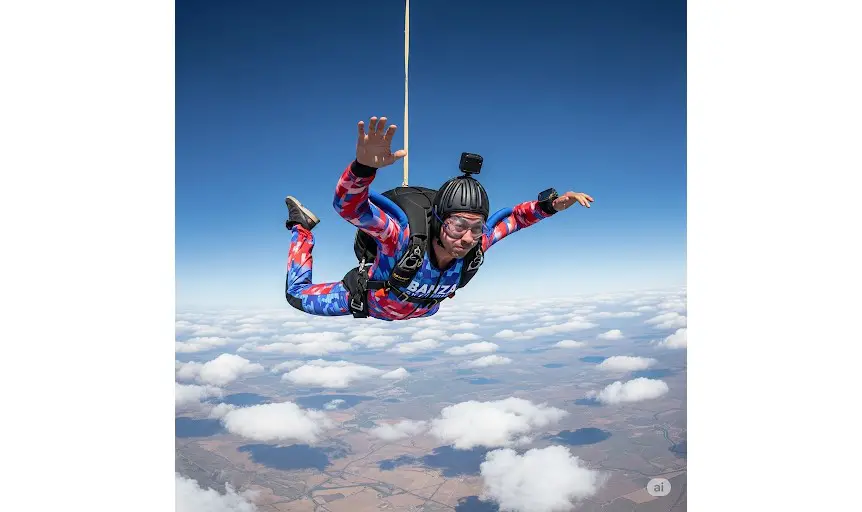
The Thrill and History of Banzai Skydiving
Banzai Skydiving is one of the most extreme and daring sports ever conceived. This thrilling activity combines skydiving with a unique challenge: jumping out of an aircraft and then catching a free-falling parachute mid-air. The adrenaline rush and unmatched skill required make it a captivating sport for both participants and spectators. Over the years, Banzai Skydiving has carved out a unique niche, drawing adventurers from around the world. In this blog, we explore its origins, global popularity, amateur and professional participation, and its social significance, along with the detailed rules that define the sport.
The Origin and History of Banzai Skydiving
The roots of Banzai Skydiving trace back to Japan in the late 1980s. Inspired by the samurai spirit and a thirst for ultimate adrenaline, Japanese thrill-seekers pushed skydiving boundaries. The name “Banzai” symbolizes courage and the willingness to embrace extreme challenges. Initially, it was more of a stunt performed for entertainment rather than an organized sport.
As videos of these early daredevils surfaced, the concept gained traction. By the late 1990s, enthusiasts in the United States and Europe began experimenting with similar jumps. Gradually, the activity evolved into a structured sport with clear rules and safety protocols. Today, it is practiced worldwide, attracting adrenaline junkies and extreme sports athletes alike.
Global Popularity and Geographic Spread
Banzai Skydiving has transcended its Japanese origins to become a global phenomenon. Countries with a rich skydiving culture, such as the United States, Australia, and New Zealand, embraced the sport wholeheartedly. Europe, with its adventurous spirit, has also become a hub for Banzai Skydiving, particularly in countries like Switzerland and France, known for their stunning alpine landscapes.
In recent years, Asian nations beyond Japan, such as South Korea and Thailand, have also started to develop communities of Banzai enthusiasts. Similarly, South American countries like Brazil and Argentina have embraced it, offering breathtaking locations for jumps. The sport’s global appeal is fueled by the rise of extreme sports festivals, where Banzai Skydiving often features as a marquee event.
Amateur Banzai Skydiving and Youth Involvement
Amateur participation in Banzai Skydiving has grown steadily. It is not uncommon to see local skydiving clubs organizing events for newcomers eager to try this heart-pounding experience. These amateur activities often take place under controlled conditions with seasoned instructors supervising every aspect of the jump.
Youth involvement, however, remains limited due to the inherent risks. While there are no official programs for schools, extreme sports organizations have started conducting workshops and simulations to introduce young enthusiasts to the concept safely. Virtual reality (VR) experiences have also emerged as a way for teenagers to get a taste of the thrill without the associated dangers.
Professional Leagues and Competitions
Professional Banzai Skydiving leagues have started to gain prominence in recent decades. In Japan, the birthplace of the sport, annual competitions draw large crowds and significant media attention. These events showcase the precision and skill of seasoned athletes. The United States has followed suit, with leagues such as the Extreme Air Sports Association (EASA) organizing high-profile tournaments.
In Europe, cross-border competitions are a highlight, with teams representing different nations. Australia and New Zealand, too, host yearly championships in conjunction with extreme sports expos. These events not only spotlight the athletes but also highlight advancements in gear and safety technology.
The global professional scene is still developing, but its potential is enormous. Sponsorships and endorsements are on the rise, allowing athletes to focus on refining their craft.
Political and Social Significance
Banzai Skydiving is more than just an extreme sport; it’s a cultural and social phenomenon. Politically, it represents the freedom of expression and the human spirit’s resilience. Countries that host major events often use them to promote tourism, showcasing their natural beauty and adventurous spirit.
Socially, the sport fosters a sense of community among participants and fans. It’s not just about the jumps but also about the camaraderie built during training and events. Banzai Skydiving has also inspired people to push their limits, encouraging self-improvement and confidence. Additionally, its growing visibility on social media platforms has turned it into a global spectacle, inspiring countless individuals to take up challenges in their own lives.
Rules of Banzai Skydiving
The rules of Banzai Skydiving are what set it apart from traditional skydiving. Understanding these rules is crucial for both participants and organizers:
- Altitude and Timing: The jump typically occurs at an altitude of 12,000 to 15,000 feet. The parachute is thrown out first, followed by the jumper a few seconds later.
- Parachute Handling: The jumper must catch the parachute mid-air within a specific timeframe. Failure to do so results in disqualification.
- Safety Equipment: Participants must wear a backup parachute and safety gear, including a helmet and altimeter.
- Landing Precision: Athletes are scored based on their ability to land accurately within a designated zone.
- Time Limit: There is a strict time limit for catching the parachute, adding to the challenge and excitement.
These rules ensure the sport remains challenging while prioritizing safety and fairness.
Conclusion
Banzai Skydiving is a testament to human courage and the pursuit of adventure. Its rich history, global appeal, and structured evolution from a stunt to a recognized sport make it truly unique. As it continues to grow in popularity, it offers participants an unparalleled experience while inspiring audiences worldwide. Whether as a professional endeavor or an amateur thrill, Banzai Skydiving represents the ultimate fusion of skill, bravery, and the spirit of adventure.




